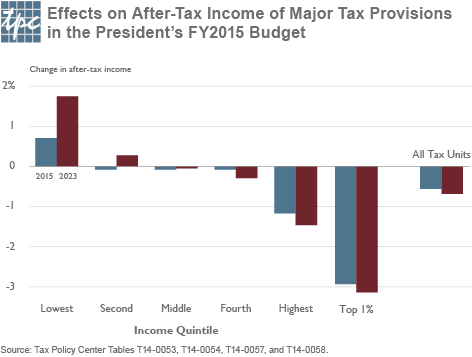The voices of Tax Policy Center's researchers and staff

When President Obama proposed his 2015 budget last March, he vowed to cut taxes for working class Americans while making sure high income households pay their "fair share." New Tax Policy Center estimates show that, like it or not, Obama would do pretty much as he promised. Low-income households would enjoy a tax cut while those at the top of the income distribution would pay more.
In 2015, for example, the president’s tax plan would boost after-tax income for the poorest 20 percent of households by about 0.7 percent while those in the top 20 percent would lose about 1.2 percent and the top 1 percent would see their income drop nearly 3 percent (blue bars in figure). Low-income workers would benefit from a substantial increase in the earned income tax credit (EITC) for childless workers and an additional child and dependent care credit for families with children under age 5. High-income families would get hit by proposed limits on tax breaks—the “Buffett Rule” and the 28-percent cap on the value of certain tax deductions and exclusions. Overall, taxes would claim an additional 0.6 percent of after-tax income that year.
The tax increase would grow slowly over time, generally at the expense of higher-income households. By 2023, average after-tax income would be 0.7 percent lower than under current law (red bars in figure). In contrast, the poorest households would get almost 2 percent more income after taxes that year, in large part because the president would make permanent the expanded refundability of the child tax credit and the increased EITC for larger families that were enacted as part of the 2009 economic stimulus legislation. Those provisions are currently set to expire in 2018.
Most of the president’s tax proposals have appeared in previous budgets, but he added four new ones this year. TPC delves into those additions in a separate analysis that accompanies the distributional estimates.
Posts and comments are solely the opinion of the author and not that of the Tax Policy Center, Urban Institute, or Brookings Institution.
